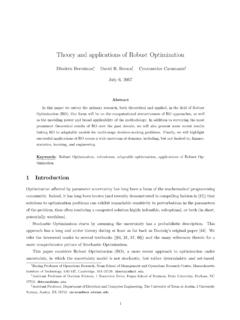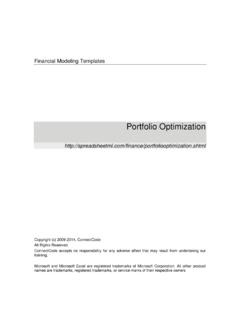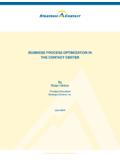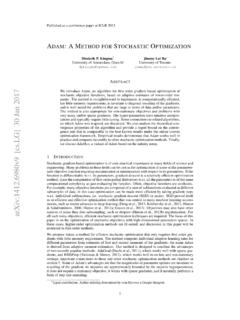Transcription of PCR Optimization Student Guide 2012 - Babec
1 PCR Optimization Table of Contents Fall 2012 Optimizing the polymerase chain Reaction Introduction ..1 Review of Mathematics ..3 Solving Problems of Dilution and Concentration: Two Approaches ..4 Experiment Overview ..7 Calculations Part 1: Overview of PCR Reaction Components ..8 Part 2: Varying the Magnesium Chloride Concentration ..10 Part 3: Varying the Primer Concentration ..15 Laboratory Important Laboratory Practices ..20 Varying Magnesium Concentration ..21 Varying Primer Concentration ..24 Agarose Gel Electrophoresis ..27 Electrophoresis of Amplified DNA ..28 Staining and Photographing Agarose Gels ..29 Interpretation of Results Role of Magnesium ..30 Role of Primers ..32 Acknowledgements.
2 33 !PCR Optimization Student Guide Fall 2012 1 !Optimizing the polymerase chain Reaction Frank H. Stephenson, Maria C. Abilock Applied Biosystems Babec Introduction The polymerase chain Reaction (PCR) is a powerful technique used for the amplification of a specific segment of a nucleic acid. Starting with only a very small amount of material, a DNA segment can be multiplied by over a million-fold. Because of this great sensitivity, PCR has found popularity in a wide range of applications. Molecular biologists use PCR in gene cloning and DNA sequencing. Forensic scientists use PCR to connect blood, semen, saliva, or tissue left at the scene of a crime to a suspect or victim.
3 Clinical geneticists use PCR to determine whether or not potential parents might carry a genetic disease that could be passed along to their children. PCR is DNA synthesis in a test tube. To perform PCR amplification, you need to combine all the components required for DNA replication. These are as follows: Template DNA. The template carries the DNA segment or target you wish to amplify. Primers. A primer is a short, single-stranded piece of DNA that anneals (attaches) to its complementary sequence on the template. A pair of primers will bind to either side of the target DNA segment providing initiation sites for DNA synthesis. The two primers used in a PCR are often designated by the terms forward and reverse.
4 DNA polymerase . This is the enzyme used to synthesize new strands of DNA. DNA polymerase adds nucleotides onto the end of an annealed primer. The added bases are complementary to the template strand. Magnesium. DNA polymerase requires magnesium for activity. Magnesium is usually supplied to a PCR amplification in the form of magnesium chloride. dNTPs. dNTP stands for deoxynucleoside triphosphate. These are the four nucleotides used by DNA polymerase to extend an annealed primer. Buffer. A buffer is a solution that resists change in pH. It is used to ensure that the DNA polymerase is in an environment in which it will have maximum activity. Although PCR is a powerful tool for the amplification of genetic sequences, it is not an exact science.
5 Sometimes, even though using an established PCR protocol that had been optimized and successful for the amplification of a particular DNA segment, use of that same protocol on a different region can result in a less than desirable outcome. Poor amplification, however, can result from one of several causes; the temperatures used for thermal cycling may not be the best, the template may be of poor quality, or a reagent (or reagents) may be at suboptimal concentration(s). The optimal reagent concentrations for any specific target/primer set and the optimal thermal cycling parameters that will give the highest yield, more often than not, are determined by trial and error.
6 Taking particular care when optimizing PCR can provide rewards in several ways. An optimized PCR will improve both product yield and reproducibility between reactions , while reducing amplification of non-specific products. When electrophoresed on an agarose gel, an optimized reaction will give a brighter product band with minimal background (Figure 1). When developing a protocol for PCR amplification of a new target, it may be important to optimize all parameters including reagent concentrations, cycling temperatures, and cycle number. For this experiment, thermal cycling parameters have been optimized for you. Your task will focus on reagent Optimization . Varying the magnesium or primer concentration usually has the most profound affect on the quality of the reaction.
7 Therefore, your class will optimize these reagents in a PCR experiment. To do this, you will amplify a segment of the acetylcholinesterase gene in cow DNA. PCR Optimization Student Guide Fall 2012 2 ! Figure 1. An optimized PCR amplification will produce a single, bright band on a gel (as seen in the left-most lane). A reaction for which conditions have not been optimized will produce multiple bands as seen in the center lane. The right-most lane contains size marker. PCR Optimization Student Guide Fall 2012 3 !Review of Mathematics This laboratory exercise requires that you calculate amounts and concentrations of various reagents. Concentration refers to the amount of a substance dissolved in a defined volume.
8 Two teaspoons of sugar dissolved in a cup of water is an example of a concentration. Two teaspoons of sugar in one cup of water is more concentrated than one teaspoon. If you make a reagent less concentrated by transferring a small amount into a new volume, you have made a dilution. For example, you dilute liquid dishwashing soap by pouring a small amount into a sink full of water. In PCR, the concentration of the individual reaction components may be expressed in different units. For example, the amount of template DNA is calculated as ng/reaction, while the concentration of primer is expressed as micromolar ( M). To perform the calculations in this protocol, you need to be comfortable using the different units and converting between units.
9 When changing between units, you must use a conversion factor, or a numerical ratio equivalent to one. For example, 100 pennies make up one dollar. The conversion factor is 100 pennies 1 dollar How would you use this conversion factor to solve the problems below? Show your work. 1. How many pennies are represented by 15 dollars? 15 dollars x 100 pennies / 1 dollar = 1500 pennies 2. How would you determine the number of dollars equivalent to 800 pennies? 800 pennies x 1 dollar / 100 pennies = 8 dollars Below is a chart showing conversion factors to help you change between units for volume measurements. Let s try some examples. Show your work. Unit Symbol Unit Equivalence Conversion Factors milliliter mL 1,000 mL = 1 liter (L) 1,000 mL or 1 L 1 L 1000 mL microliter L 1,000,000 L = 1 L 1,000 L or 1 mL 1 mL 1000 L Table 1: Conversion Factors for Volume Measurements 3.
10 How many L are equivalent to milliliters? mL x 1000 L / 1 mL = 3300 L 4. Express 450 L as milliliters. 450 L x 1 mL / 1000 L = mL When you need to convert between units for measurements of mass, Table 2 may be helpful. PCR Optimization Student Guide Fall 2012 4 ! Unit Symbol Unit Equivalence Conversion Factors milligram mg 1,000 mg = 1 gram (g) 1000 mg or 1 g 1 g 1000 mg microgram g 1,000,000 g = 1 g 1000 g or 1 mg 1 mg 1000 g nanogram ng 1,000,000,000 ng = 1 g 1000 ng or 1 g 1 g 1000 ng Table 2: Conversion Factors for Mass Measurements Use the conversion factors from the chart above to change between mass units.







